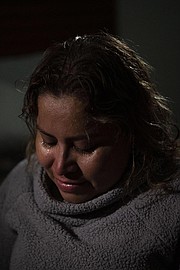MEXICALI, Mexico -- Twenty-nine parents from across Central America who were separated from their children by U.S. immigration agents last year returned to the U.S. border Saturday, demanding asylum hearings that might allow them to reunite with their children.
The group of parents quietly traveled north over the past month, assisted by a team of immigration attorneys who hatched a high-stakes plan to reunify families divided by President Donald Trump's administration's family separation policy last year.
The 29 parents were among those deported without their children, who remain in the United States in shelters, in foster homes or with relatives.
Although the Trump administration's family separation policy has prompted a round of congressional hearings, lawsuits and national protests, the parents have for nearly a year suffered out of the spotlight from their homes in Honduras, Guatemala and El Salvador. They celebrated birthdays and Christmas on video calls, trying to discern if their children were safe.
Now, they will pose a significant test to America's embattled asylum system, arguing that they deserve another chance at refuge in the United States, something rarely offered to deportees. Before the Trump administration, families had never been systematically separated at the border. And before Saturday, those families had never returned to the border en masse.
More than 2,700 children were separated from their families along the border last year, according to the Department of Health and Human Services. About 430 of those were deported without their children, and at least 200 of them remain separated today.
On Saturday, the group of parents walked toward the border, flanked by religious officials, and then waited at the entrance to the United States as the attorneys negotiated with U.S. officials.
The parents sat on wooden benches, surrounded by their luggage, while officials decided how many, if any, of the parents to allow into the country.
Over the past three weeks, the parents stayed in a Tijuana hotel, sharing rooms and preparing for their asylum hearings. They showed one another documents that their children had sent them: photos of foster families and report cards from Southwest Key, a company that runs shelters for migrant children.
A woman explained through tears how her daughter had tried to kill herself while in government custody. A man spoke about trying to communicate with his daughter, who is deaf, over a shelter's telephone. Others carried bags full of belated Christmas gifts for their children.
Many of the parents, like Jose Ottoniel, from the tiny town of San Rafael Las Flores, Guatemala, said they had been pressured into signing deportation papers after being separated from their children, before they could begin their asylum claims. When he returned home after being deported in June, Ottoniel was told that his 10-year-old son, Ervin, was still in the United States, at a shelter.
The family chose to keep Ervin in the United States with an uncle, rather than forcing him to return to the violence and poverty of the family's village. It was a wrenching decision that Ottoniel's wife, Elvia, who had remained in Guatemala when Ottoniel had tried to cross the border, eventually decided she couldn't live with. In January, she paid a smuggler $8,000 to travel to the United States to reunite with Ervin in Arkansas, applying for asylum in south Texas.
A few days later, Ottoniel received a call from an American immigration attorney with the Los Angeles-based legal advocacy group Al Otro Lado. The attorney asked him if he was willing to travel the 2,500 miles from his village to the U.S.-Mexico border to deliver himself once again to immigration agents.
Al Otro Lado had received more than $1 million in financial assistance from organizations such as Families Belong Together and Together Rising, which mounted fundraising campaigns in the midst of the government's separation policy. The lawyer told Ottoniel that the organization would pay for his bus travel, flights and hotels.
"At that point, we were already seeing some of these parents paying smugglers to bring them back to the U.S.," said Erika Pinheiro, litigation and policy director for Al Otro Lado, which had interviewed deported parents from across Central America who feared for their lives after being deported without their children. "We needed to provide them with another option."
For Ottoniel, who referred to his family as "disintegrated," it seemed his best shot at a reunion.
"It was a chance to see my son again. How could I say no?" he explained.
Ottoniel and other parents converged at a three-story hotel in Tijuana, where lawyers told them to remain quiet about their plans. They rehearsed how they would address U.S. immigration officials. At night, they called their children across the border.
There was Luisa Hidalgo, 31, from El Salvador, whose daughter, Katherinne, 14, is in the Bronx in New York with a foster family. The girl texted her mother the same words over and over: "Fight for me."
There was Antolina Marcos, 28, who said she fled Guatemala after gangs began killing members of her family. She was separated from her 14-year-old daughter, Geidy, in May. "How can I live when she's so far away?" Marcos said.
There was Santos Canelas, 44, who said he fled Honduras with his 16-year-old daughter, Merin, in May after gang members threatened to sexually assault her. She is living in New Orleans with a cousin. "Without my daughter, I'm dead inside," he said.
In most of the 2,700 cases when the Trump administration separated families at the border last year, both the parents and children remained in the United States, sometimes held in shelters and detention centers thousands of miles apart. Almost all of those families have now been reunified and are pursuing their asylum claims.
But the cases of the parents deported without their children were particularly difficult. Often, the government lost track of which child belonged to which parent, and it did not link their immigration cases, sending parents back to Central America without telling them where their children were.
In some of those cases, parents later made the painful decision to keep their children in the United States. In other cases, the U.S. government determined that the parents were unfit to receive their children, often based on their criminal records.
After Trump signed an executive order officially ending the family separation policy on June 20, lawyers launched a legal battle to reunify many of the deported parents and their children in the United States.
The American Civil Liberties Union filed a lawsuit demanding that the government allow 52 parents back into the United States to pursue their asylum claims, which the lawyers argued had been stymied after the parents were separated from their children at the border.
But the government has not responded to that appeal and later said it needed more information about the parents from the ACLU. It remains unclear when, or if, the U.S. government will invite those parents back to the United States to launch new asylum claims.
"The government has resisted bringing anyone back who was separated and deported without their kids," said Lee Gelernt, deputy director of the ACLU's Immigrants' Rights Project. "We hope the government will take a fresh look at these cases."
But as the government refused to articulate any plan to reunify the families, Pinheiro decided waiting much longer would put the parents at risk. Some had relocated to a safe house in Guatemala City to escape threats in El Salvador and Honduras. Some had already been without their children for more than a year, and those separations were taking a psychological toll.
"We gave them the option -- you can wait for the court process, or you can do it this way," Pinheiro said. Al Otro Lado worked with the ACLU to identify the separated parents in Central America, but the ACLU was not involved in getting the 29 parents back to the border.
With few other options, Pinheiro said, almost every parent she approached accepted her offer. The parents first gathered in the Guatemalan city of Tecun Uman before crossing into Mexico with humanitarian visas that Al Otro Lado helped arrange. They flew to Mexico City and then to Tijuana, eventually taking a bus to Mexicali.
"We're traveling back to the border where we lost our children in the first place," said Pablo Mejia Mancia, 53, from Honduras, who was separated from his 9-year-old daughter when they crossed the border into Texas in May.
It's likely that some of the parents could be detained for months if the government decides to process their asylum claims. But even if they are refused entry to the United States in the coming days, U.S. courts could eventually allow some of the parents back into the country to petition for asylum.
For now, though, the parents say they hope their long trip back to the border will be the fastest way to see their children again. The U.S. policy of forcing asylum seekers to wait in Mexico has not yet been implemented in Mexicali.
"They're standing right at the border, preparing to re-enter a system that traumatized their families months earlier," said Lindsay Toczylowski, executive director of the Immigrant Defenders Law Center, who counseled the parents in Tijuana. "It says a lot about what they're fleeing, and what they lost."
A Section on 03/03/2019

